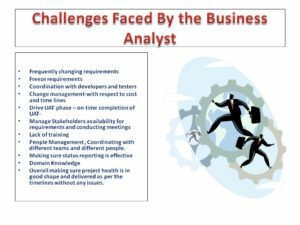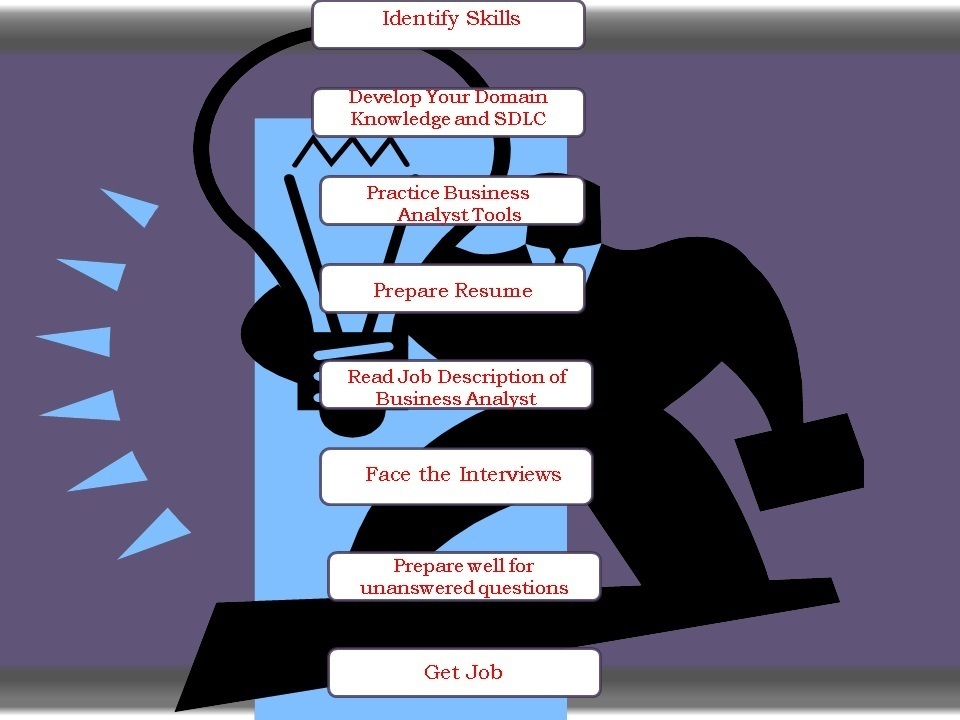How to Become a Business Analyst
Here whatever I mentioned is based on my own experience; I feel it may help to someone who are preparing for BA and trying to get job as a Business Analyst.
A BA is in charge of understanding a business’s changing needs, and providing technological solutions to improve its processes and systems. Thus, a business analyst is often thought of as the link between the business and IT departments.
Let us discuss in-detail below to understand how to become a BA and what are the skills needed to prove as a BA.
How to become a Business Analyst
Once we got information from our friends or colleagues related to BA career and if we decided to become a Business Analyst, then first question in our mind is how to become a Business Analyst.
Then we start discussing or inquiring more about BA and start thinking about “How to become a Business Analyst and what skills needed to become a BA. Here I am trying to give some inputs which may answer to your question “How to become a Business Analyst”
Identify Skills:
Before deciding to become BA first identify what are the skills needed to become a BA and what BA will do on daily basis. Most of the people may think communication is very important to become BA that is partially true. Communication means not only speaking in English, as s BA we should know what to speak and what not to speak and how to convince the stakeholders. Once you identify the skills, analyze yourself whether you are suitable for this position or not. Once you decided that you are suitable for this position then start improving skills to become BA.
How to identify Skills :
Now a days we can get more BA blogs and videos online, we can get to know by reading BA blogs and watching some videos on YouTube.
What are the skills needed to become a Business Analyst
Develop Your Knowledge as a Business Analyst:
Once you decided that you are suitable for this position then start improving skills to become a Business Analyst by reading Business Analyst related blogs and by watching videos. And you can discuss with your seniors who can help you to build your career as a BA Start understand, how software application will be developed and what challenges team faced during the development of the Project. And start thinking as a BA, if you are in that situation as a BA then how you will react and you will resolve the issues are problems.
What BA does on his/her day to day life
Role of BA in a Project
Develop your Domain Knowledge:
Domain knowledge is very important for BA Example for Domain Knowledge: Banking, Insurance, Finance, Healthcare, Telecom etc… Domain knowledge will help you to understand client requirements easily. You may think that as a fresher how I can get Domain Knowledge. Start discussing with your friends and seniors who are working on multiple domains and multiple organizations. Try to understanding by them how bank will work and how IT Company will work. Most of the companies will not expect Domain knowledge if you are attending interview as a Fresher, but it is good to have some knowledge.
What is Domain Knowledge
What is domain knowledge and why domain knowledge is important for BA
Practice BA Tools:
BA will use some prototyping tools to capture the requirements. Stake holders can understand by seeing the prototypes what is the requirement and what client is expecting by this requirement.
What are the tools used by BA
Documents prepared by the BA during the SDLC
Prepare Resume:
Once you are confident then start preparing the resume and start attending to interviews. And ensure your resume should not be a template; change the resume as per the job description and company requirement. Before attending to any interview read the job description carefully and prepares yourself what interviewer is expecting from you and how to answer to him.
Don’t worry and don’t disappoint if you not answered any question, note down the questions which you not answered and prepare well for those. Don’t lose your confidence and keep attending the interviews.
Read Job Description of BA
Start Attending the Interviews:
Note down the questions:
I feel it helps you to understand how to become a BA/
Once you understand how to become a BA, then you can start prepare your resume and start attending interview.
Business Analyst Certification
FAQS:
What qualifications do you need to be a business analyst?
Desirable qualifications
Undergraduate degree in subjects such as computer science, business information systems, computing and systems development, and business management.
Postgraduate qualification
How do I start a business analyst career?
To start a career as a business analyst, initially educate yourself as a business analyst person by undergoing some business analyst training. Get certified: There are a number of BA certifications widely recognized in the industry today.
Is it hard to become a business analyst?
Business analysis is hard.
It’s an extremely creative activity – occasionally frustrating but generally very satisfying. I used to come home most days feeling like I’d done a good day’s work and would still have plenty of energy to apply myself to extra-curricular activities in the evening.
Is business analyst a good career?
A good business analyst can move from industry to industry with ease. You can move to where the work is needed. You are a very flexible resource. It is also a well paid career.
How do I become a business analyst with no experience?
Learn From Other Business Analysts.
Do Some Research On BA Work Deliverables.
Seek Out Training Opportunities.
Master Soft Skills.
Participate in Business Analysis Tasks.
How is business analyst as a career?
After eight to 10 years in various business analysis positions, you can advance to chief technology officer or work as a consultant. You can take the business analyst career path as far as you would like, progressing through management levels as far as your expertise, talents and desires take you.
Does business analyst need MBA?
MBA degree is not necessary for an individual to take up a Business Analyst (IT Business Analyst) role. Those who start their IT business analyst careers , most of the times do not have good skills in all the three areas. … So an MBA is not necessary to take up an IT business analyst role.
How is business analyst career path?
After eight to 10 years in various business analysis positions, you can advance to chief technology officer or work as a consultant. You can take the business analyst career path as far as you would like, progressing through management levels as far as your expertise, talents and desires take you.
Is business analyst a technical job?
No, it is not. It is more of a techno-functional role but doesn’t require technical skills. Here are some extracts from Adaptive US’ blog on Business Analyst Job Description : … Managing requirements both at the project level and organization level are vital in fulfilling business needs.

Business Analyst , Functional Consultant, Provide Training on Business Analysis and SDLC Methodologies.




